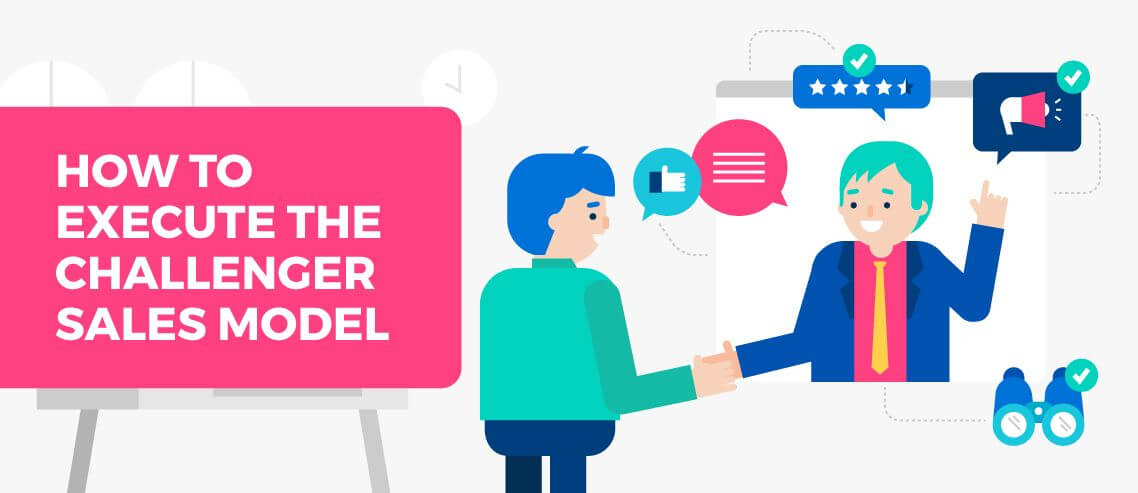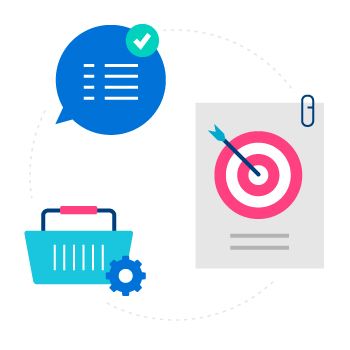How to Execute the Challenger Sales Model

Contents
As salespeople, we like to picture the sales process a little like this:
- We reach out to a prospect
- Through subtle questioning and persuasion, we identify their business challenges and position our product as the solution
- Convinced by our expertise, they buy from us
But in reality, it doesn’t normally go like that. In fact, the average customer is already 57% of the way through the buying process when they first make meaningful contact with us.
At that point, they already have pretty clear ideas about the type of product they need, the features they’re looking for, and how much it’ll cost.
In this context, a sales rep’s role has to change. They can either become an order-taker, waiting for a customer to get in touch and giving them exactly what they ask for.
Or they can reposition themselves as a challenger.
What Is the Challenger Sales Model?
 In their book The Challenger Sale, Matthew Dixon and Brent Adamson argue that sales reps fall into one of five categories:
In their book The Challenger Sale, Matthew Dixon and Brent Adamson argue that sales reps fall into one of five categories:
- Challengers
- Hard workers
- Relationship builders
- Lone wolves
- Problem solvers
As you probably guessed, their sales model is centered on the first category: Challengers. It states that Challengers are best placed to deliver strong results in the current sales climate, through their ability to:
- Teach prospects
- Tailor their approach to each sale
- Take control of the sales process
So who exactly are the Challengers? Well, according to Adamson and Dixon, they’re reps who:
- Love to debate
- Aren’t afraid to push the customer
- Have a deep understanding of the customer’s business
- Look at the world in a different way
Does that sound like the people on your sales team?
If not, don’t worry. Adamson and Dixon say any rep can become a Challenger, even those who currently fall into one of the other four categories. All it takes is the right training and tools.
What’s the Evidence for the Challenger Sales Model?
If you’re not currently used to challenging your customers, you might be wondering what all the fuss is about.
Surely it’s better to just give the customer what they want, rather than risk losing the deal by trying to lead them in a different direction?
Well, you’d be wrong.
To measure the effectiveness of the Challenger Sales Model, Gartner surveyed more than 6,000 sales reps, assessing “average” and “star” performers across 44 different attributes.
Their findings were striking.
In particular, they discovered that a majority of reps fall into the “Relationship Builder” category. They’re highly adept at holding enjoyable conversations with prospects, geared toward resolving tensions and satisfying demand.
However, just 7% of Relationship Builders were star performers – the lowest proportion of any category.
In contrast, Challengers are prepared to disrupt their customers’ current thinking and teach them something new.
While this approach might lead to more difficult conversations and occasional conflict, it yields by far the best results. Almost 40% of star performers were Challengers, rising to 54% in complex sales scenarios.
What Behaviors & Characteristics Do Challengers Display?
 It’s pretty clear that there are big advantages for reps who adopt the Challenger approach.
It’s pretty clear that there are big advantages for reps who adopt the Challenger approach.
But doing that will likely involve some significant changes in behavior. Adamson and Dixon say Challengers are able to leverage their assertive personalities to display three key skills:
- Based on their knowledge of the customer’s business, their capacity to see the world differently, and their ability to develop a two-way dialogue, they educate on differentiation rather than following the status quo.
- Leveraging their understanding and intuition for the customer’s financial and value-based pain points, they’re able to tailor their messaging for each sales interaction.
- They feel able to seize control of the sales process, because they’re comfortable discussing financial terms and pressuring the customer to close the sale.
For some reps, all of that will come naturally. Some will find it relatively easy to adapt to the Challenger model with just a little thought and a few subtle adjustments to their current methodology. But others will inevitably struggle to implement the Challenger model successfully without some outside help.
This is why it’s important that the whole sales operation – and, indeed, the entire organization – embrace the Challenger approach. That way, front-line reps will always be able to access the support and key insights they require to lead the customer conversation.
3 Steps to Implementing the Challenger Sales Model
Like what you’ve heard so far? Then you’re probably keen to adopt the Challenger Sales Model yourself. Here are three practical steps you can take to make it happen.
1. Educate Customers on Your Value
Challengers succeed by teaching customers, rather than simply fulfilling a list of demands.
That means they need to be able to educate customers on the benefits of your product. And to do that, they first need to develop a deep understanding of your value proposition.
First, as an organization, you need to define the specific selling points of your product. Why would a prospect choose you over a rival? Which features make the biggest difference? What are the real “wow” moments that justify the price tag?
 The next step is to define the best way of communicating these key differentiators to potential customers.
The next step is to define the best way of communicating these key differentiators to potential customers.
This is where the Challenger model really comes into its own.
Traditionally, reps might try to build a mutual connection to sell their product. “Oh, so you struggle with X? A lot of other prospects tell me that. Well, here’s how our product can help.”
But remember: only 7% of Relationship Builders are top performers.
Instead, your sales pitch should be all about teaching prospects, based around the concept of “show me, don’t tell me.”
Reps should use their knowledge of the prospect’s business and challenges to define the key benefits that will make the biggest difference, then walk the prospect through specific use cases and case studies that clearly demonstrate the value in your product.
Content marketing plays a key role in supporting this approach. Rather than relying solely on your reps to teach prospects, create content geared toward educating potential customers on your product’s most valuable features before that first touchpoint with your sales team even happens.
2. Use Messaging That Resonates With Your Audience
Chances are you have more than one audience.
Look at Mailshake. We only sell one product, helping businesses send personalized cold emails at scale, but its potential users range from sales teams to SEO link-builders. Clearly, those are two very different audiences, so our messaging needs to change depending on the prospect in question.
The same is true for you.
It’s hard to overstate the importance of personalization in the sales cycle, but here are a couple statistics that show why it’s no longer a “nice to have”:
- Almost three-quarters of buyers say they’ll only engage with sales messaging that’s tailored to their needs
- More than two-thirds say joined-up processes, such as contextualized engagements based on previous conversations and interactions, play a very important part in convincing them to buy
- 92% of marketers state that customers and prospects expect a personalized experience
An important point here: personalizing your messaging doesn’t just mean using the prospect’s name at the start of an email, or referencing their organization in a piece of sales collateral.
Instead, it means gearing your whole sales experience toward solving the specific challenges your customer is facing.
Once you understand those challenges, you can follow the Challenger mindset to teach your prospect about the various ways your product provides the perfect solution.
But personalization should also be happening before the prospect has even spoken to one of your reps.
For instance, say they want to download your new ebook. Your data capture form could support your personalization strategy by asking the prospect to give their job title, or choose which department or business function they work within.
That information should be added to your CRM so that all future communications can be tailored to the common pain points and challenges faced by people in their role or department.
3. Take Control of the Sale
Everything you’ve done up to this point puts you in the perfect position to take control and lead your prospect through the sales cycle.
Now, it’s time to make that happen. After all, taking control is front and center of the Challenger Sales Model.
Of course, the steps required to “take control” may vary from one scenario to another. But broadly speaking, your goal should be to set clear steps for progressing this opportunity toward a close that your prospect simply can’t say “no” to.
That could look like this:
- Step 1: Discovery sales call between the rep and a technical lead on the client side; someone who understands the need for a product like yours, but likely lacks the authority to sign off on financial decisions.
- Step 2: Request a follow-up call with someone further up the chain of command, with the authority to make buying decisions.
- Step 3: Use assertive questioning to dig deeper into the client’s circumstances. What systems are they currently using? How effective are these systems? What’s the scope for improvement? What would be the impact of adopting your product instead?
- Step 4: Take the information gathered from all previous interactions to build a personalized solution that perfectly meets the customer’s needs. Additionally, do your homework to anticipate potential objections and find ways to overcome them.
Make the implications of choosing your product as clear as possible. For instance, spell out the financial cost – through lost productivity, or lower conversions, or a smaller sales pipeline – of continuing to operate without your product.





